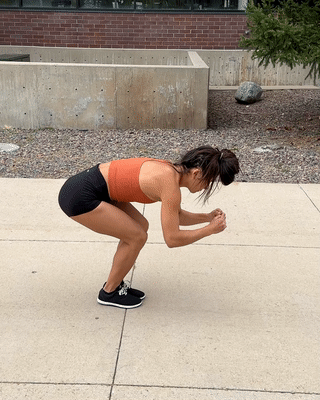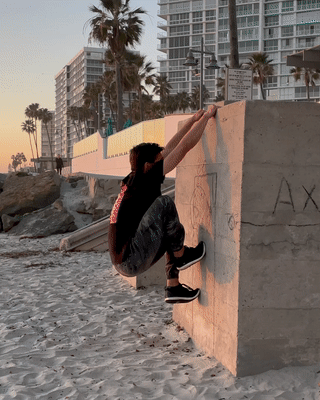If your climb-up needs work, consider drilling the progressions in this blog post. For most of these movements, remember to put extra emphasis on training them with ambidextrous footwork, smooth rhythm, and precision landings that are as tall/stable as possible.

Keep in mind that there are many progressions between the main ones listed below. For example, you can make a kong-up harder by incrementally increasing the wall height (e.g. ankle-high, knee-high, hip-high, etc). Or you can make running climb-ups harder and more versatile by reducing approach steps (e.g. start with a 3-step run-up and gradually progress & reduce down to a 2-step, 1-step, half-step).

Even if you have advanced climb-ups, there’s still value in using all of the fundamental climb-up pieces and progressions to fine-tune your climb-up. For example, drilling running climb-ups with a focus on quick, clean footwork will make your cat hang climb-ups faster too. Or if you need better climb-up ambidexterity for stronger speed parkour, go back a few progressions to fill any gaps on your dark side (aka oppo or bad side).

→ For an alternative approach to learning and teaching the climb-up, check out our beginner guide: Intro to climb-up strength & skill training
→ To unlock our most comprehensive climb-up training/coaching resource, consider purchasing our digital training manual: Climb-Up Blueprint
Ground kong
Ground kongs are useful for building basic leg & upper-body pushing strength, as well as full-body coordination. Think of it like an odd burpee with a staggered start and a stick landing finish. As you get better at this movement, combine it with jumps and sprints for better transitions. Be sure to drill this one with a split-foot takeoff as it will carry over better to kong vaults for speed/power/distance/etc. (versus a feet-together/punching takeoff).
Useful prereqs:
Progressions:
Kong-up
Kong-ups are useful for building basic strength and power, as well as full-body coordination. Think of it like a more complex box jump, or a 3-dimensional burpee. A kong-up will bring you to a partial squat position on top of an obstacle—useful as you transition into a jump or run. Be sure to drill this one with a split-foot takeoff as it will carry over better to kong vaults for speed/power/distance/etc. (versus a feet-together/punching takeoff).
Useful prereqs:
Progressions:
Top-out
As the final part of the climb-up, top-outs are a key skill for all levels to continue practicing in some way. Top-outs are explosive full-body movements that require a quick heel drive, a tight tuck, and a powerful pop through the arms, shoulders, & back. At first, you may need to land 1 or 2 legs slightly to the side but eventually, work up to landing on the wall with both feet (symmetrically & precisely).
Walking climb-up
The walking climb-up is primarily for building better climb-up footwork skill & speed. The main goal is to get things down here with slow/low-impact before moving on to the running climb-up.
For beginners, walking climb-ups build general climb-up strength, skill, & work capacity. Beginners should do them in almost every climb-up training session! For advanced athletes, walking climb-ups & running climb-ups are more like an end of warm-up and/or light(ish) speed drill to refine & maintain minor technical details of the climb-up.
Running climb-up
The running climb-up is primarily for building better climb-up footwork skill & speed. It also happens to be 1 of the best climb-up drills out there, for all levels. This is because the running start offloads some of the work from the upper to the lower body. It allows you to train more reps, build more skill, and with less wear and tear on your wrists, elbows, & shoulders.
For beginners, running climb-ups build general climb-up strength, skill, & work capacity. Beginners should do them in almost every climb-up training session! For advanced athletes, running climb-ups are more like an end of warm-up and/or light(ish) speed drill to refine & maintain minor technical details of the climb-up.
Useful prereqs:
Progression series 1 (use a taller wall):
- Running climb-up (3-step run-up, shoulder-high)
- Running climb-up (3-step run-up, head-high)
- Running climb-up (3-step run-up, standing-reach-high)
Progression series 2 (use less run-up):
Jumping climb-up
The jumping climb-up is used as an in-between progression for when your running climb-ups are good but your cat hang climb-ups still need work. Jumping climb-ups take away the running momentum but still allow a minor assist in the form of your bottom/grounded leg helping to hop you up into the skill. It allows you to train more reps, build more skill, and with less wear and tear on your wrists, elbows, & shoulders.
For beginners, jumping climb-ups build general climb-up strength, skill, & work capacity. However, if you’re struggling with jumping climb-ups, go back to walking climb-ups & running climb-ups instead. For advanced athletes, jumping climb-ups are more like an end-of-warm-up and/or light(ish) speed drill to refine & maintain minor technical details of the climb-up.
Useful prereqs:
Progressions:
Climb-up
As 1 of parkour’s most unique & utilitarian movements, the climb-up is a must-have skill for anyone interested in functional, obstacle-based training. Extremely relevant to real-world situations, it is a wicked demonstration of both power and agility. Need to quickly ascend a tall wall or fence? You could awkwardly struggle your way up, or you could whip out a perfectly executed climb-up. If time was of the essence and somebody’s survival was at stake, climb-up strength & skill is critical.
With proper training and attention to detail, the climb-up is your key to the urban jungle. Owning this technique is the difference between people who need to be saved by Spiderman and people who are capable of saving themselves (and others). Which would you prefer?
Useful prereqs:
Progressions:
Ryan Ford is founder of Apex School of Movement, director of Parkour Strength Online course, & author of Parkour Strength Training book.
